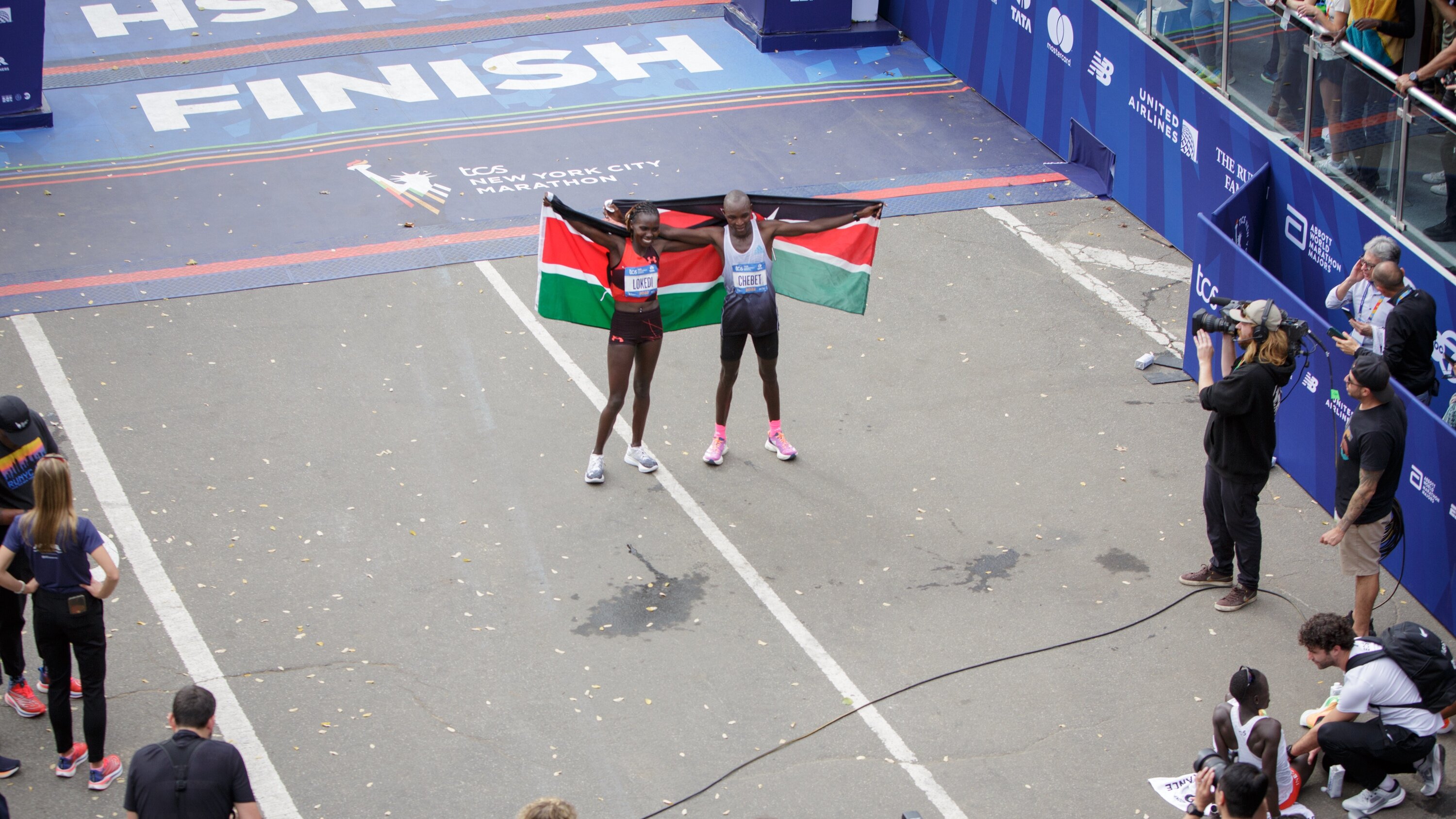Home>Misc>Featured>What Is A Staggered Start In Track And Field


Featured
What Is A Staggered Start In Track And Field
Published: September 6, 2023
Learn about the featured topic of staggered start in track and field, its rules, benefits, and how it affects race outcomes.
Introduction
Welcome to the exciting world of track and field! From sprints to long jumps, this sport is full of thrilling events that test an athlete’s speed, strength, and technique. One of the key aspects of track and field is the start, where athletes position themselves on the starting line before launching into action. In many events, such as the 100-meter dash, the start can make all the difference between victory and defeat.
But have you ever wondered why athletes in track and field races don’t start at the same time? That’s where the concept of a staggered start comes into play. A staggered start is a technique used in track and field to ensure fair competition and take into account the advantages and disadvantages of each lane on the track.
In this article, we will explore the definition, purpose, and mechanics of a staggered start in track and field. We will delve into the benefits of this technique, as well as the challenges and considerations that come along with it. Additionally, we will provide examples of different staggered start techniques that are commonly used in various track events.
So, whether you’re a track and field enthusiast, an aspiring athlete, or simply curious about the intricacies of the sport, let’s dive into the fascinating world of the staggered start in track and field!
Definition of a Staggered Start
A staggered start in track and field refers to the practice of positioning athletes at different starting points along the track. Instead of all competitors starting at the same time, each athlete begins their race from a predetermined distance behind the athlete in the adjacent lane. This staggered positioning compensates for the varying distance to the finish line for each runner, ensuring fairness in competition.
The distance between each athlete in a staggered start is calculated based on the radius of the track and the number of lanes. In events such as the 100-meter dash, where there are usually eight lanes, the athletes in lanes one and eight have the farthest distance to cover. To address this discrepancy, they are positioned farther back from the start line, while athletes in the middle lanes have a shorter distance and start closer to the line.
Staggered starts are typically used in races that take place on a circular track, such as the 200-meter, 400-meter, and 800-meter events. In these races, the curvature of the track makes it impossible for all runners to cover the same distance from their respective starting points to the finish line. By implementing a staggered start, track and field competitions ensure that each athlete experiences an equal distance and comparable conditions, regardless of their assigned lane.
The practice of a staggered start is not exclusive to track events. It can also be seen in other sports, such as swimming and rowing, where lanes are used. The purpose remains the same: to account for variations in distances and provide equal opportunities for all participants.
Now that we have a clear understanding of what a staggered start entails and its widespread use across different sports, let’s explore the purpose and benefits of this technique in track and field!
Purpose of a Staggered Start in Track and Field
The primary purpose of implementing a staggered start in track and field is to ensure fair and equitable competition. Since tracks are curved, athletes in outer lanes have to cover a longer distance compared to those in inner lanes. Without a staggered start, athletes in the outer lanes would face a significant disadvantage due to the extra distance they have to cover.
A staggered start addresses this issue by adjusting the starting positions of athletes relative to their assigned lanes. By positioning athletes at different starting points, the distance each athlete needs to cover from their respective starting point to the finish line is equalized to the best extent possible.
Another purpose of a staggered start is to minimize the potential advantage of the inner lanes. In many track events, such as the 400-meter race, the inner lanes are considered more favorable because the curves on the track are less severe. By positioning athletes at a staggered start, the advantage of the inner lanes is mitigated, creating a more level playing field for all competitors.
The staggered start also serves as a strategic element in track and field. Athletes must carefully plan their race strategy, taking into account their starting position and the position of their competitors. In races where positions can be overtaken, athletes in outer lanes may choose to start at a faster pace to gain an advantageous position early on.
Furthermore, the staggered start adds excitement and drama to track and field events. It introduces an element of unpredictability as athletes navigate the curves and try to strategically position themselves for a strong finish. This anticipation and suspense can enhance the spectator experience, making track and field events even more thrilling to watch.
Overall, the purpose of a staggered start in track and field is multifaceted. It aims to ensure fairness, minimize the advantage of inner lanes, introduce strategic elements to races, and enhance the excitement of the sport. With this understanding of the purpose behind a staggered start, let’s now delve into how it works in practice.
How a Staggered Start Works
Now that we understand the purpose of a staggered start in track and field, let’s take a closer look at how it works in practice. The mechanics of a staggered start involve carefully positioning athletes at different starting points based on their assigned lanes.
Before the race begins, runners are called to their respective lanes. The starting positions are calculated using a mathematical formula that takes into account the number of lanes and the size of the track. The goal is to ensure that athletes in outer lanes have an equal distance to cover compared to those in inner lanes.
For example, in an eight-lane track event, runners in lanes one and eight will have the farthest distance to cover due to the curve of the track. They will be positioned farther back from the start line to account for this extra distance. The runners in the middle lanes, such as lanes four and five, will start closer to the start line, as they have a shorter distance to cover.
The staggered start is typically implemented using a sequence or “waterfall” method. This means that the athletes in the outer lanes start first, followed by the athletes in the middle lanes, and finally the athletes in the inner lanes. This staggered sequence allows for a smooth and efficient flow of the race, ensuring that each athlete has ample space and time to operate.
As the race begins, athletes sprint down the track at their maximum speed. The staggered start ensures that all competitors have an equal distance to run, regardless of their assigned lane. This helps to level the playing field and determine the winner based solely on speed, technique, and strategy.
It’s important to note that while the staggered start aims to create fairness in competition, variations in track conditions, wind speed, and other factors can still influence the outcome of the race. Nonetheless, the staggered start is a crucial technique in track and field that helps to counter the discrepancies caused by the curved track and provides athletes with equal opportunities for success.
With a solid understanding of how a staggered start works, it’s time to explore the benefits that this technique brings to track and field events.
Benefits of a Staggered Start
The implementation of a staggered start in track and field brings several benefits to both athletes and spectators. Let’s explore some of the key advantages of using a staggered start in track events.
1. Equitable Competition: The primary benefit of a staggered start is that it ensures fair competition. By adjusting the starting positions based on assigned lanes, the staggered start equalizes the distance each athlete needs to cover. This helps to eliminate any potential advantages or disadvantages caused by the curvature of the track, guaranteeing that the race is fair for all participants.
2. Level Playing Field: In track events where inner lanes are traditionally considered more advantageous due to milder curves, a staggered start helps to minimize the advantage of these lanes. By positioning athletes at different starting points, the staggered start creates a more level playing field, giving competitors in outer lanes an equal opportunity to showcase their abilities.
3. Strategic Decision-Making: The staggered start adds a strategic element to track and field events. Athletes must carefully plan their race strategy, taking into account both their starting position and the position of their competitors. They may choose to start at a faster pace to gain an advantageous position early on or conserve their energy for a strong finish. This strategic decision-making adds excitement and complexity to the races.
4. Enhanced Spectator Experience: The staggered start brings an element of suspense and unpredictability to track events. As athletes navigate the curves and strategically position themselves, spectators are captivated by the anticipation of a thrilling finish. This heightened excitement increases the overall spectator experience, making track and field events more enjoyable to watch.
5. Promotion of Skill Development: The staggered start encourages athletes to develop a range of skills, including effective starting techniques and the ability to navigate curves. This promotes well-rounded training and helps athletes develop the necessary skills to excel in their respective events. By creating an equalized race environment, the staggered start supports the growth and development of athletes at all levels.
Overall, the benefits of using a staggered start in track and field cannot be overstated. It fosters equitable competition, levels the playing field, adds strategic elements, enhances the spectator experience, and promotes skill development for athletes. These advantages contribute to the overall excitement and integrity of the sport.
Now that we’ve explored the benefits, it’s important to also consider the challenges and considerations that come with implementing a staggered start in track and field events.
Challenges and Considerations of a Staggered Start
While a staggered start brings numerous benefits to track and field events, there are also challenges and considerations that need to be taken into account. Let’s explore some of the key challenges and considerations associated with implementing a staggered start.
1. Complex Calculations: Determining the appropriate starting positions for athletes in a staggered start requires precise calculations based on the track size and number of lanes. This can be a complex task that requires careful attention to detail and accuracy. Any miscalculations can significantly impact the fairness and integrity of the race.
2. Variable Track Conditions: Even with a staggered start, track conditions can still vary from lane to lane. Factors such as the quality of the track surface, presence of wind or obstacles, or differences in temperature can affect athletes differently. While a staggered start helps to equalize distances, these external factors can still influence the outcome of the race.
3. Adjustment Period: For athletes used to starting from a fixed position, adapting to a staggered start can require an adjustment period. Athletes must train to become familiar with starting from different positions and be able to adapt their strategies accordingly. This adjustment period may introduce additional challenges and feelings of uncertainty among the athletes.
4. Strategic Timing: The staggered start introduces a strategic element to races, where athletes must carefully time their pace and positioning to maximize their chances of success. This adds an extra layer of complexity to their race strategy and decision-making, which requires mental and tactical preparedness.
5. Execution Consistency: Ensuring that the staggered start is executed consistently across different races and events can be challenging. It requires proper training and coordination among officials to accurately position athletes at the starting line and ensure a fair start for all competitors. Consistency in execution is vital to maintain the integrity of the sport.
6. Logistical Considerations: Implementing a staggered start requires careful coordination and communication among race officials, athletes, and coaches. Timely and accurate information must be provided to athletes regarding their assigned starting positions and other race logistics. This coordination can be logistically challenging, especially for events with a large number of participants.
It is important to acknowledge these challenges and considerations when utilizing a staggered start in track and field. Addressing these factors ensures that the staggered start is implemented effectively and fairly, enhancing the overall integrity and success of the sport.
Now, let’s move on to exploring some specific examples of staggered start techniques commonly used in various track events.
Examples of Staggered Start Techniques
Staggered start techniques can vary depending on the specific track event and the number of lanes in play. Here we will explore some common examples of staggered start techniques used in various track events.
1. Waterfall Start: The waterfall start is one of the most common staggered start techniques used in track and field. In this technique, athletes in the outermost lanes start first, followed by the next set of lanes from the outside, and so on until the inner lanes start last. This sequential start ensures a smooth flow of the race and equalizes the distances for all runners.
2. Cutoff Start: In events with a large number of lanes, such as the 200-meter dash on a nine-lane track, a cutoff start technique may be employed. In this technique, a specific lane cutoff point is established, beyond which athletes start at the same line. For example, in a nine-lane track, athletes in lanes one to six start at staggered positions, while athletes in lanes seven, eight, and nine start from the same line.
3. Alternate Start: In some events, such as the hurdles or relay races, staggered start techniques can be modified. For hurdles, athletes start from staggered positions, but the start line is adjusted to ensure that the distance to the first hurdle is consistent for all participants. In relay races, the staggered start is organized as a running start, where athletes begin running before receiving the baton from their teammate at the exchange zones.
4. Separate Straightaway Start: In events where the track design includes a straightaway before entering the curved section of the track, a separate straightaway start technique can be employed. Athletes start in a staggered formation on the straight section of the track before merging into their assigned lanes on the curve. This technique allows for a smoother transition and minimizes the disruption caused by merging athletes.
5. Dynamic Lane Start: In events like the 400-meter race, where the inside lanes are preferred due to milder curves, a dynamic lane start technique can be used. Athletes start at staggered positions but may be assigned different starting lanes, rotating with each race to ensure fairness. This technique ensures that athletes have an equal opportunity to start from the desirable inner lanes and experience comparable distances during races.
These are just a few examples of staggered start techniques used in various track events. The specific technique employed depends on factors such as track design, the number of lanes, and the rules and regulations of the event. It is important for race organizers and officials to establish and communicate the appropriate staggered start technique for each event to ensure fair and competitive races.
With a better understanding of staggered start techniques, it’s clear that they play a vital role in maintaining fairness and equal opportunities in track and field events. Let’s summarize our findings in the following section.
Conclusion
The staggered start is a fundamental technique used in track and field to ensure fair competition and account for the varying distances on a curved track. By positioning athletes at different starting points based on their assigned lanes, the staggered start equalizes the distance each runner needs to cover, creating a level playing field for all competitors.
Throughout this article, we have explored the definition, purpose, and mechanics of a staggered start in track and field. We have seen how a staggered start addresses the disadvantages of outer lanes and minimizes the advantages of inner lanes, promoting equitable competition. The staggered start also adds a strategic element to races, enhancing the spectator experience and promoting skill development for athletes.
We have discussed the challenges and considerations associated with implementing a staggered start, including complex calculations, variable track conditions, and the need for coordination among officials and athletes. These factors must be carefully managed to ensure the integrity of the staggered start and the fairness of the entire race.
Furthermore, we have explored examples of staggered start techniques commonly used in various track events, such as the waterfall start, cutoff start, alternate start, separate straightaway start, and dynamic lane start. These techniques demonstrate the adaptability and versatility of staggered starts to accommodate different track designs and event requirements.
In conclusion, the staggered start is an integral component of track and field events. It not only provides fair competition by equalizing the distances for athletes in different lanes but also adds excitement, strategy, and skill development to races. By implementing the appropriate staggered start technique and addressing the inherent challenges, track and field organizers can ensure that competitions are conducted with fairness, integrity, and the utmost enjoyment for athletes and spectators alike.









